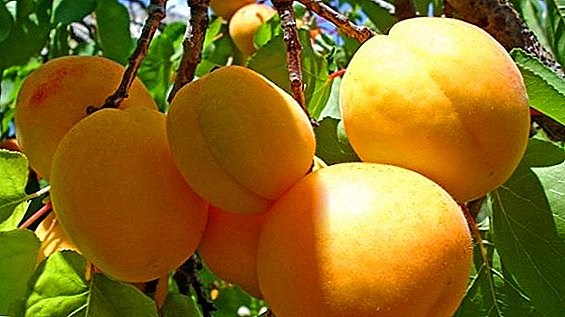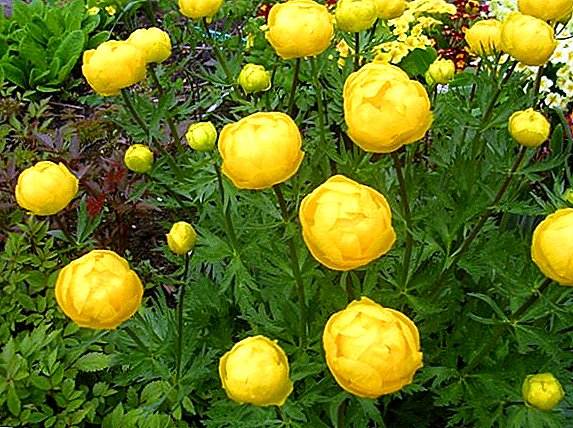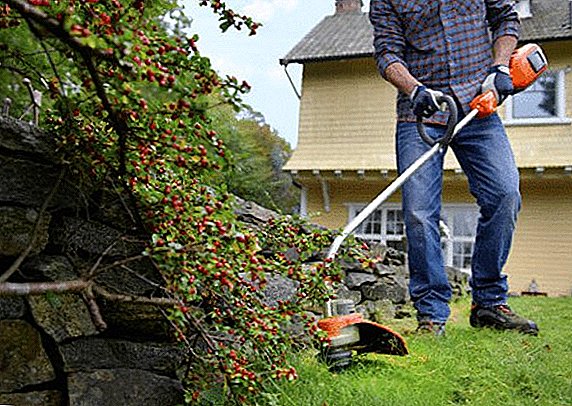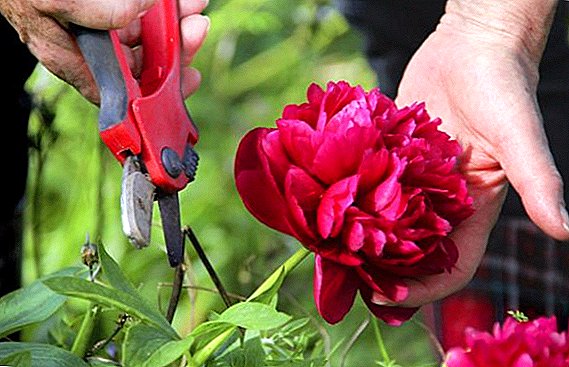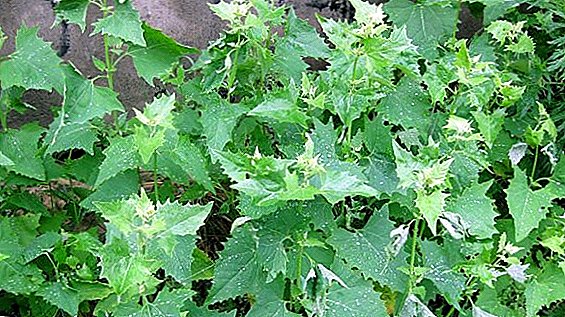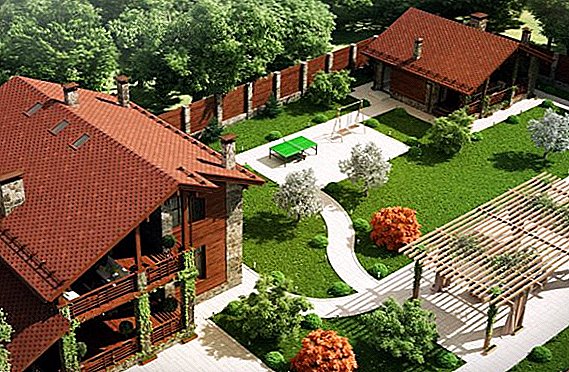 A plot of 10 acres is a fairly large area that can be used to house a house, bookmark a garden, greenhouses or vegetable beds, play or sports playground for children, and even an artificial reservoir. With rational use there will be enough space for any projects, the main thing is to properly plan the placement of objects in the territory.
A plot of 10 acres is a fairly large area that can be used to house a house, bookmark a garden, greenhouses or vegetable beds, play or sports playground for children, and even an artificial reservoir. With rational use there will be enough space for any projects, the main thing is to properly plan the placement of objects in the territory.
Regularities of planning
Any project starts with a layout. 
In this case, first of all it is necessary to consider:
- Relief: smooth, sloping, hilly. When placing objects on a hilly area, you need to consider whether you will align the territory or irregularities can be used in the design of the garden, recreation areas. Irregularities affect the placement of the house, the laying of utilities, planting trees.
- The form also affects the placement of buildings and communications. Considered the best square and rectangular shapes.
- Plot location regarding the cardinal points. This is especially important if the territory has an elongated shape, and you plan to place greenhouses, greenhouses or an orchard.
- Soil type influences the choice of plants that can be grown on the site. The soil can be not only fertile, but also sandy, loamy, marshy. It is necessary to take into account the condition of the soil when laying the foundation of buildings.
- Neighboring facilities. The presence of a nearby natural reservoir affects the groundwater level and soil moisture. Trees create shady areas in which plants grow poorly. In the shadow area do not place the building because shading does not allow them to warm up well and contributes to increased dampness inside the building.
- General climatic characteristics of the area: average temperatures, precipitation also affect the choice of plants and the design features of buildings.
 Professional packages can have an evaluation version of the program for a period from 10 to 30 days (shareware). Programs are convenient because they allow you to choose the shape of a plot, set dimensions and place on virtual space objects from a library of elements: a house, a tree, a bush, a playground, a garage, etc. For the visualization to be true, a shape is selected for the objects to be placed and the size is set.
Professional packages can have an evaluation version of the program for a period from 10 to 30 days (shareware). Programs are convenient because they allow you to choose the shape of a plot, set dimensions and place on virtual space objects from a library of elements: a house, a tree, a bush, a playground, a garage, etc. For the visualization to be true, a shape is selected for the objects to be placed and the size is set.Did you know? The percentage of citizens who have a country site varies from 60 to 80% in different countries of the world. In the USSR, 58% of the population had dacha plots, and the standard size of a plot was 6 acres. In Europe, it is 62% of the population, but the plots are much smaller - only 3 weave.
Types of land planning
Landscape designers are considering 6 basic schemes of territory planning, depending on which lines prevail on it.
Types of layouts:
- rectangular and square;
- round;
- diagonal;
- curvilinear incl. with the presence of arcs;
- irregular.
Learn how to properly equip the garden area, how to align it, make lighting, flower garden and orchard.
Rectangular
A rectangular shape is the most common form in planning. If the area is completely empty, then it is not difficult to optimally place all the desired objects. At the same time, they try to set the house in such a way that its shadow from the north side falls outside the border of the territory, leaving a maximum of well-lit territory inside.  If you purchased a plot with buildings already placed on it and in the surroundings of other sites, then when planning, pay attention to how the shadows are laid in order to leave a well-lit area for the horticultural sector and the recreation area.
If you purchased a plot with buildings already placed on it and in the surroundings of other sites, then when planning, pay attention to how the shadows are laid in order to leave a well-lit area for the horticultural sector and the recreation area.
Square
The square shape is less convenient than the rectangular one, but it also allows you to create great plans considering the different zones and the laying of the tracks between them. Square and rectangular shape is easy to divide into different sections, zoned and get the optimal combination of elements. 
Round
The basis of circular planning is the principle of placing all zones in the form of circles that can intersect with each other. The site should have one main circle, around which various elements of the landscape are located. Placement is performed on the rays crossing the center of the main circle.
Inside the main circle there may be a residential building, a gazebo, or another object that will become the center of the composition. When planning such a plot, first draw a diagram on graph paper. Then draw the main circle and the rays passing through the center. Now it remains to place the necessary objects on the basic scheme.
You will be interested to learn how to make a veranda, garden swing, stone grill, flower bed, rockeries and a gazebo in the country house with your own hands.
Diagonal
Diagonal layout occurs in uneven areas. The basic design rule for such a site is the placement of elements along the diagonals that extend from corner to corner. Such a scheme visually expands the space and makes it possible to create unique layouts. 
Free
In the irregular territory marking scheme, several different planning methods can be used: radial, diagonal, rectangular. Design elements of different zones can move one into another or exist in independent zones, harmoniously combining with each other.
At the same time, the existing relief forms are entered into the design. For the landscape area use original transitions from cultural forms to the wild. This layout can be used on the site of any shape.
Landscape design at the dacha - make beauty.
Plot facilities
There are four main areas:
- residential;
- rest zone;
- economic;
- horticultural.
 Residential zone occupies about 10% of the plot with a house, a garage, a terrace. The economic zone includes outbuildings, animal enclosures and occupies 15%. The recreation area consists of gazebos, a game or sports ground, a pool, a summer kitchen and occupies 25% of the territory. The remaining 50% is a garden area where greenhouses, beds, garden, flower beds, artificial reservoir, park can be placed.
Residential zone occupies about 10% of the plot with a house, a garage, a terrace. The economic zone includes outbuildings, animal enclosures and occupies 15%. The recreation area consists of gazebos, a game or sports ground, a pool, a summer kitchen and occupies 25% of the territory. The remaining 50% is a garden area where greenhouses, beds, garden, flower beds, artificial reservoir, park can be placed.
How to arrange buildings
The location of the residential building should be such that the maximum lighted space remains for the recreation area and landings. Plants grow better on the south side of the building, so residential buildings are recommended to be placed in the north of the site. Such placement of buildings also allows to protect plants from northern winds. The shape of the trees can be any. With the help of trees and bushes zoning is performed.
Farm buildings should not be visible from the entrance to the site. They can be placed behind the house. If you are going to keep the birds, you need to provide for their area of walking in such a way that people and birds do not interfere with each other. Trees are placed around the perimeter of the site, as a separate garden, as well as along the perimeter of the recreation area. If the greenhouse will be used for growing vegetables - it is placed on the south side of the house.  The recreation area is arranged so as to provide both good illumination and a shadow sector for those who would like to relax in the shade. Recreation area items need not be close by. Paths are the shortest distance between buildings. They are placed so that they are neither too long nor too narrow.
The recreation area is arranged so as to provide both good illumination and a shadow sector for those who would like to relax in the shade. Recreation area items need not be close by. Paths are the shortest distance between buildings. They are placed so that they are neither too long nor too narrow.
Did you know?Birds of the hut or perch family of the family at the moment of choosing a couple build huts and decorate them. For decoration, feathers, shells, and elytra of beetles are used. The female will choose the one who, from her point of view, is a more skilled builder.
Space zoning
Space zoning is necessary in order to give the sectors completeness and visual closeness. Basic zoning techniques:
- paving;
- terracing;
- curbs;
- Creek;
- canopy;
- partitions and screens;
- fixtures;
- furniture.
Paving is a planar zoning method. The base for it is created at the planning stage of the site. Paving is grounds, paths, lawns. It can be made in the form of elements of different colors or textures. It may also be grooves filled with gravel or curbs. Borders can be limited to functional areas, terraces, they can become seats at a children's play area, an additional table at a terrace.  The height of such borders is about 40 cm and width is about 30 cm. They can be designed as capital structures with a closed top or with flower beds in the upper part. Portable versions are also possible, designed in the form of wood stumps, etc. The border can be decorated with fresh flowers and be a flowerbed, and an element of division of sectors. The boundaries of the zones are often made out of container plants.
The height of such borders is about 40 cm and width is about 30 cm. They can be designed as capital structures with a closed top or with flower beds in the upper part. Portable versions are also possible, designed in the form of wood stumps, etc. The border can be decorated with fresh flowers and be a flowerbed, and an element of division of sectors. The boundaries of the zones are often made out of container plants.
Important!The depth of the trench under the lighting system must be at least 50 cm. Laying technique: a layer of sand, cables and again a layer of sand. The cable must be three-core necessarily laid in an armored pipe.A narrow canal or stream can mark the boundaries of the site, turning it into an island. Openwork partitions create the boundaries of sectors, contribute to the privacy of the sector. Lighting fixtures are a universal solution that has both zoning and lighting of the plot. Lamps can be ground, or placed at a height.
Terrace
Terraces are among the most spectacular methods of space design, but their creation requires considerable effort, the construction of support walls, the sleep of them with fertile soil, etc. Ground cover plants look good on terraces. Terraces can be made of stone or wood. This layout is also suitable for recreation areas - it allows you to select areas, play areas, swimming pool, lawns.  Sheds are fixed structures made of metal, plastic or wood. The roof of the shed may be formed by climbing plants. Also, the roof can be made of polycarbonate. This is a modern building material, characterized by high strength and good transparency. The same material is used in modern greenhouses.
Sheds are fixed structures made of metal, plastic or wood. The roof of the shed may be formed by climbing plants. Also, the roof can be made of polycarbonate. This is a modern building material, characterized by high strength and good transparency. The same material is used in modern greenhouses.
Paths and flower beds
The tracks allow you to quickly move around the site and are made of various materials: concrete, paving slabs, pebbles, stone, clinker tiles. Coatings can be combined. The simplest version of the track is gravel. Asphalt plots do in the parking lot of the car.
Important! For lighting garden compositions, artificial reservoirs and recreation areas - low-voltage halogen lamps and LEDs can be used. It is prohibited to install equipment with a voltage of 220 V in artificial reservoirs.Garden compositions can include unusually shaped woody material, stones and flowers. Perennials are planted in the middle of a flower bed, and annuals - on its edges. The forms of beds can be very different: round, oval, rectangular, curvilinear. A flower bed can be an array of flowers or a hedge.
Lawn
The lawn is a green lawn for a recreation area. Laying a lawn requires the prior destruction of weeds and leveling the soil. If the soil is not level, this will create problems when mowing the lawn. In addition, the uneven lawn looks untidy, the grass pokes out in the pits and bald patches are formed, which is also not very beautiful.  A special lawn grass is planted on the prepared site. In addition to universal lawn mixtures, you can buy bluegrass meadow, ryegrass, oatmeal, timothy meadow, fenders. Lawn care consists of watering, feeding, cleaning possible weeds and cutting grass.
A special lawn grass is planted on the prepared site. In addition to universal lawn mixtures, you can buy bluegrass meadow, ryegrass, oatmeal, timothy meadow, fenders. Lawn care consists of watering, feeding, cleaning possible weeds and cutting grass.
Did you know? Rolled lawn is one of the most practical solutions for landscaping the site. It consists of twisted grass rolled into a roll, it is very simple and beautiful to use.
Water
A small artificial reservoir fits well with the design of the site. His task - the visual expansion of space. In addition to the aesthetic component, the evaporation of water in hot weather provides the necessary coolness for plants and recreation areas. The most popular forms of reservoirs:
- pond;
- Creek;
- fountain;
- waterfall.
Reservoirs are both regular geometric shape and curvilinear, inscribed in the landscape. The most common form is the oval. The shore of an artificial reservoir can be made in the form of a border, decorated with water-loving plants. The pond requires careful maintenance incl. garbage collection, foliage and water treatment. Planning the site is not a difficult task.  The main thing is to correctly take into account the labor costs, the capabilities of the performers and calculate the finances when the project is implemented. A variety of modern building materials, design options for ponds, paths, lawns and other elements is extremely large, because it allows you to choose the most original, modern solutions. Show imagination, but remember that everything must be harmoniously combined and consistent with the overall style.
The main thing is to correctly take into account the labor costs, the capabilities of the performers and calculate the finances when the project is implemented. A variety of modern building materials, design options for ponds, paths, lawns and other elements is extremely large, because it allows you to choose the most original, modern solutions. Show imagination, but remember that everything must be harmoniously combined and consistent with the overall style.


